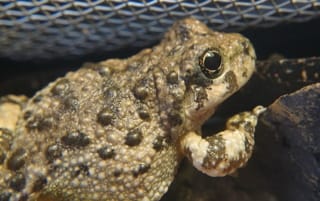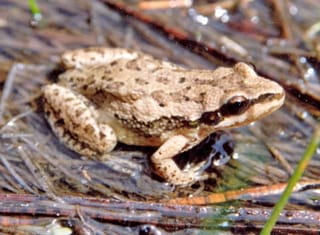This guide initially displays common reptiles and amphibians of all shapes. Use the selectors below to view particular shapes, include rare species, or search by name.
Reptiles are a group of vertebrate animals that are cold-blooded, i.e., they regulate their inner body temperature by responding to the temperature of their environment, basking in the sun to warm themselves up or lying in the shade to cool off. Animals in the class Reptilia include snakes, lizards, crocodiles, turtles and tortoises. All of these creatures are covered in scales and breathe air through their lungs throughout their lifetime. In addition, they all produce eggs. Most reptiles lay eggs from which young hatch directly after an incubation period. However, some snakes, including rattlesnakes, carry their eggs internally and then give birth to live young.
Like reptiles, amphibians (frogs, toads, newts, salamanders and worm-like caecilians) are cold-blooded vertebrates. However, unlike reptiles, animals in the class Amphibia do not have scales but rather have skin that is permeable so that molecules and gases can pass through it. In addition, they lay their eggs in water where the young are born as larvae using gills to breath. The larvae grow and change into the adult form. This process includes developing lungs thus allowing the adults to live on land. Amphibians are considered to be the link between fish and reptiles as they were the first animals to leave the water and come onto land.
The question often arises of how to tell the difference between a frog and a toad. Although they are closely related amphibians, there are some features that can be used to distinguish them. Frogs have long hind legs for jumping, moist and usually smooth skin and bulging eyes. In addition, they typically stay in water. Toads have short legs for walking and hopping, dry and bumpy skin and do not have bulging eyes but do have poison glands behind their eyes. They mostly stay on land.
This guide describes the modest number of amphibians and reptiles including two venomous snakes that can be found in Los Alamos and the surrounding areas. An excellent reference for more information is Amphibians and Reptiles of Los Alamos County by Teralene S. Foxx, Timothy K. Haarmann, and David C Keller.
Reptile and Amphibian References
Amphibiaweb
Amphibians and Reptiles of Los Alamos County [PDF]
Bartlett, R.D., Bartlett, P.P., 2013 New Mexico’s Reptiles and Amphibians: A Field Guide. University of NM Press
Biota Information System of New Mexico
Degenhardt, W.G., Painter, C.W., Price, A.H., 2005 Amphibians and Reptiles of New Mexico. University of NM Press
eNature
Encyclopedia of Life
New Mexico Herpetological Society
The Reptile Database
Subject Area Experts (all guides)
Steve Cary (butterflies)
Beth Cortright (insects)
Terry Foxx (invasive plants)
Leslie Hansen (mammals)
Richard Hansen (fish, mammals)
Dorothy Hoard (butterflies, trees)
Chick Keller (flowers, herbarium)
Shari Kelley (geology)
Kirt Kempter (geology)
Garth Tietjen (reptiles)
David Yeamans (birds)
Web Development and Content Management
Pat Bacha
Jennifer Macke
Graham Mark
Akkana Peck
Contact
Please contact us for local nature questions and sightings. We welcome comments, corrections, and additions to our guides.
For more information about local nature, please visit our Nature Blog or subscribe to PEEC This Week.
Make Selection
 Photo: Beth Cortright |  Canyon Treefrog(Hyla arenicolor)Family: Hylidae (Treefrogs) Size: 1.3 - 2.3 in (3 - 6 cm) Status: native; common Habitat: arid areas close to rocky washes, running water and permanent pools Typical location: White Rock Canyon In the spring, the walls of White Rock canyon echo with the call ("ba-a-a") of the Canyon Treefrog. This frog is camouflaged, and its color depends of the rocks to which it clings. The tips of the toes are expanded into small adhesive disks that allow the frog to cling tightly to rock surfaces. While this frog may be mistaken for a toad, it is distinguished from toads by its large toe pads and the unique shape of the iris of its eye. The size varies, but these frogs are smaller than the palm of one's hand. The frog breeds in streams and in rain pools on rock cliffs. Tracks Info Photos Distribution Featured |
 Photo: Teralene Foxx |  Western Chorus Frog, Stripped Chorus Frog(Pseudacris triseriata)Family: Hylidae (Treefrogs) Size: 0.8 - 1.5 in (2 - 4 cm) Status: native; common Habitat: grassy agricultural areas, suburbs, and woodlands This is a brown, olive-green or grayish frog with a dark stripe that extends through the nostril to the groin. It is small, less than 2 in (5 cm), but it has a mighty loud voice and is usually heard, not seen. In the early spring (April-March) the "crrrreeek" or "prrreep" (like the sound made by running a fingernail over the small teeth of a comb) can be heard in areas where there is still or slow-moving water. Tracks Info Photos Distribution Featured |
